In the past few months the 400W Double Ended (DE) lamps have generated significant interest among the reef hobbyists. These lamps were tested in a previous article [1], this article presents test results on the fixtures/reflectors available for these lamps. The reflectors were tested using the same setup and methodology as used for the tests on other reflectors, described in [2,3]. The data is also presented in an identical manner with plots for light dispersion for each reflector at distances of 6″, 9″ and 12″ from the center of the lamp. This article continues in a similar vein and presents the data and analysis of the 400W DE reflectors manufactured by HappyReefing.com and Icecap.
| Reflector | Ballast | Lamp |
|---|---|---|
| HappyReefing.com | 400W PFO HQI Ballast | HappyReefing 400W DE 10000K |
| Icecap | 400W PFO HQI Ballast | HappyReefing 400W DE 10000K |
To enable a direct comparison, the Icecap fixture was modified to accept the HappyReefing.com’s 400W DE 10000K lamp and to run on the PFO HQI ballast. Thus both reflectors are tested with the same lamp and ballast, allowing for a direct comparison.
The arrival of the 400W DE lamps posses the question – Are the 400W DE lamps much better than their single ended counterparts? As seen in the earlier article, the 400 DE lamp and ballast with the highest PAR output (400W DE 10000K from Happyreefing.com – 229 PPFD) is comparable in output to the single ended lamp and ballast with the highest PAR output (400W XM 10000K on a Taiwan HQI ballast – 224 PPFD). The next question is – Do the reflector systems for the 400W DE make the lamp/ballast/reflector system for the DE lamps produce more light than the SE versions.
To address this question, a comparison is made with the 400W Diamond Light Lumen Arc III reflector data (tested previously in [2,3]).
The data for the Lumen Arc III reflector running a Ushio 400W 10000K lamp on a magnetic (M59) ballast was presented in [2]. Since this was tested using a completely different lamp and ballast, an adequate comparison can only be made by using a SE lamp and ballast with similar light output. In this case this would be the XM400W 10000K running on the Taiwan HQI ballast. The PPFD for the Ushio 400W with magnetic ballast at 18″ from lamp was 123 PPFD and that of the XM 400W 10000K with the Taiwan HQI ballast was 224 PPFD. So, if the XM lamp and Taiwan HQI ballast was used in the Lumen Arc III reflector, the raw data for the Lumen Arc III should be scaled up by a factor of (224/123 = 1.82). Given that the lamp geometry is the same for the Ushio and the XM it is reasonable to assume that the reflector output will scale with lamp intensity. The data for the scaled Lumen Arc III reflector is also presented for comparison.
Reflector Data and Analysis
The data plots for each reflector at the distances 6″, 9″, and 12″ are plotted as a surface graph, top view graph, and a % distribution graph to illustrate the intensity and spread at different points on the measuring grid. Table 2 below shows the list of figures associated with each reflector.
| Reflector | Figures |
|---|---|
| HappyReefing.com | Figs. 1-3 |
| Icecap | Figs. 4-6 |
| Lumen Arc III (scaled) | Figs. 7-9 |
One of the measures of a reflector performance could be its ability to direct light into the aquarium. A reflector’s total incident light upon a surface of a given area is representative of the performance of a reflector. It is computed by adding up all the measurements taken at the discrete points within the region. It demonstrates how much light the reflector is able to focus downward when compared to other reflectors with similar operating conditions (same ballast and lamp). While it can be argued that adding all the PPFD values is technically not a valid measure as per the definition of PPFD (since PPFD is defined as microEinstiens/m2/sec), it can be used to provide a metric for reflector performance. Further summing over the data points on a given area can easily be used to compute the average, if so desired. Since the area under consideration is the same for all reflectors, we can just as well use the sum of the PPFD values distributed over this area (169 data points) instead of an average as a performance metric.
Table 3 presents this data for the reflectors in this article.
| Reflector | Distance | 3×3 Area | 2×2 Area | 1×1 Area | Maximum PPFD |
|---|---|---|---|---|---|
| HappyReefing.com | 6″ | 67182 | 66279 | 52482 | 4301 |
| 9″ | 63171 | 56095 | 36483 | 2155 | |
| 12″ | 62405 | 53254 | 30652 | 1578 | |
| Icecap | 6″ | 80762 | 79618 | 63988 | 6203 |
| 9″ | 76455 | 70041 | 46540 | 3523 | |
| 12″ | 72019 | 60286 | 36489 | 2434 | |
| Lumen Arc III – scaled | 6″ | 83979 | 83900 | 61047 | 4459 |
| 9″ | 82476 | 77864 | 54223 | 2799 | |
| 12″ | 77809 | 68892 | 39242 | 1852 |
In addition to knowing how much light is incident on a given area, we could also look at how much loss of light occurs on a given area when moving the lamp and reflector higher. Table 4, presents the % of light lost on a specified area as one moves the lamp/reflector from 6″ to 12″ above the surface. A higher % loss would indicate that the reflector is creating a larger spread.
| Reflector | 3×3 Area | 2×2 Area | 1×1 Area |
|---|---|---|---|
| HappyReefing.com | 7.1 | 19.65 | 41.59 |
| Icecap | 10.8 | 24.28 | 42.9 |
| Lumen Arc III – Scaled | 7.3 | 17.8 | 35.7 |
Conclusion
This article is the 4th in this series and presents the data and a brief analysis of the 400W DE reflector systems available in the hobby and comparison with the 400W Lumen Arc III reflector. The data provided shows that the 3 different reflector systems have a different geometric distribution of light, with the HappyReefing.com reflector having a more rounded light distribution, compared to the Icecap reflector which has a more oval distribution. The Lumen Arc III has a square distribution. From the intensity plots it is also quite clear that the Icecap reflector does provide higher amounts of light leaving the reflector compared to the Happyreefing.com reflector. The peaks attained by the Icecap reflector are much higher than the other reflectors, and in all case these reflectors produced peak values that far exceed mid day PAR values in the tropics (~2000), albeit on a small area . This should be taken into account when placing the reflectors over the tank. To mitigate the effect of the high intensity at the center, it might be advisable to run these reflector at least 12 inches above the water surface. Further, it can also be seen from the data that the DE systems are comparable performance to SE systems.
In conclusion, the 400DE systems are an attractive option for the reef aquarist, however the data does not support the view that the 400W DE systems significantly outperform the SE systems available.
Acknowledgements
We would like to thank several people whose help made this study possible. They were kind enough to provide us with lamps, reflectors and ballasts for testing: Patrick at PFO Lighting, Andy at Icecap and Nguyen at HappyReefing.com.
References
- Joshi, S. 2004. Spectral Analysis of 400W Double Ended Metal Halide Lamps http://www.advancedaquarist.com/2004/10/review
- Joshi, S. and Marks, Timothy. 2003. Analyzing Reflectors: Part I – Mogul Reflectors http://www.advancedaquarist.com/2003/3/aafeature1
- Joshi, S. and Marks, Timothy. 2003. Analyzing Reflectors: Part II – Mogul Reflectors http://www.advancedaquarist.com/2003/3/aafeature2


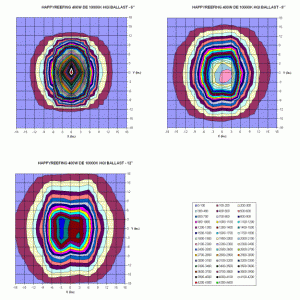
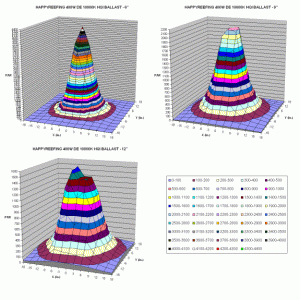
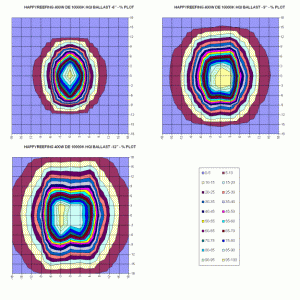
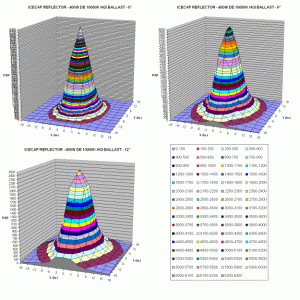
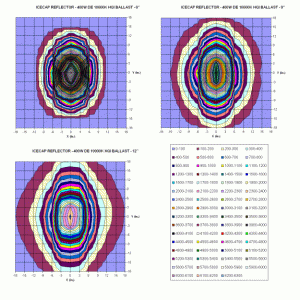
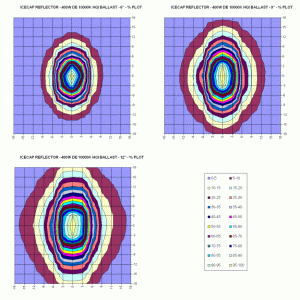
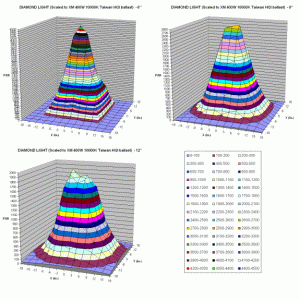
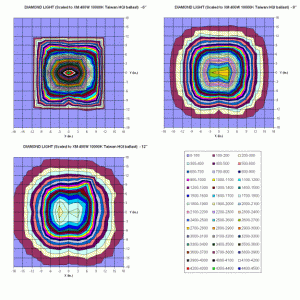
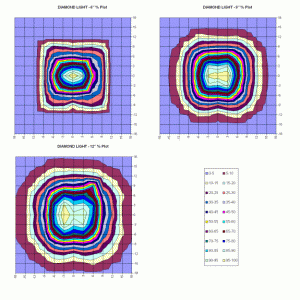

0 Comments